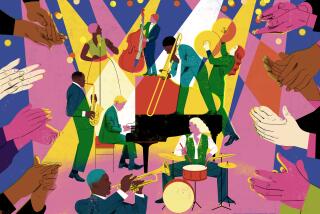Les Brown Still Commands a Band of Renown
- Share via
COSTA MESA — “That brought back such memories,” said a silver-haired woman to her companion as the throng left the Robert B. Moore Theatre at Orange Coast College early Sunday evening, savoring Les Brown’s dandy performance.
True, Brown--one of the last two active bandleaders of the swing era, along with Tex Beneke--offered fans a bit of nostalgia by playing such old favorites as “Leap Frog,” his theme since 1942, and the requisite “Sentimental Journey,” originally a hit for Brown’s Band of Renown when sung by Doris Day in the early ‘40s.
But the success of Sunday’s concert wasn’t due merely to tuneful recollections. Brown, a vital 84, who climaxed his opening “Leap Frog” by jumping about a foot into the air, brought a first-rate program marked by well-crafted, modern-leaning arrangements and superb musicianship from his crew.
The band consisted of such ace players as saxophonists Rusty Higgins, Roger Neumann and Dick Mitchell, trombonist Andy Martin, trumpeter Jack Coan, pianist Chuck Hoover and drummer Jack Sperling. These musicians and their solid cohorts gave spine to the simpler numbers and tackled the tougher tunes with aplomb.
Brown, a convivial host whose lone drawback was announcing the soloists’ names at the peak of applause, when it was hard to hear him, started off with “I’ve Got You Under My Skin,” arranged by Frank Comstock, who was in the audience.
Like many tunes during the concert, “Skin” featured smoothly swinging phrases from the saxes that were contrasted by rhythmic accents from the trombones or, in this case, muted trumpets. The arrangement seemed to glide along effortlessly, a trademark of the Brown sound.
The subsequent rendition of “I Can’t Get Started” proved that, while Brown is a swing bandleader, his soloists are mostly be-boppers.
Higgins, a 19-year vet of the band, offered a thick, creamy ringing tone a la Sonny Stitt and played warm, fluid lines over rich trombone backing, ending with a high-note zinger. Brown then joked, “If I could play like that, I’d get my own band.”
Brown consistently showcased his star soloists. Hoover was like a dancer in silhouette as he played tinkling fills on “Tenderly,” fitting his crisp notes in between the band’s textures.
Martin employed his fat T-bone sound and ability to change directions on a dime on “Have You Met Miss Jones,” closing with a cadenza that boasted a garland of pretty notes. Coan crackled punchy phrases for “On a Clear Day.” And Neumann’s tenor was often highlighted, as on “Woodchopper’s Ball,” where he used repeats of a single note to generate motion.
*
Then there were the singers. Les Brown Jr., who possesses a clean tenor that recalls Steve Lawrence, was at his best on slow songs such as “What a Wonderful World,” where he worked with feeling and was backed nicely by clarinets, flutes and trombones.
Linda Price delivered “Sentimental Journey” with understated drive and added a breathy flute solo to boot. Butch Stone--at 84 he’s a 55-year vet of Brown’s band--sang with spirit and verve on the humorous “A Good Man Is Hard to Find.”
Brown surprised fans by playing two adaptations of concert works: Ravel’s “Bolero” and Gershwin’s “Rhapsody in Blue.” The latter, orchestrated by Comstock, was exhilarating to hear as Higgins played the glorious opening clarinet theme, the trombones offered the main melody. Tonal colors--from, say, clarinets against muted trombones--swirled wonderfully. “Blue” provided a grand climax to a very fine affair.
More to Read
The biggest entertainment stories
Get our big stories about Hollywood, film, television, music, arts, culture and more right in your inbox as soon as they publish.
You may occasionally receive promotional content from the Los Angeles Times.










